- © 2024 The Jacques Cartier and Champlain Bridges Incorporated
- Terms of Use
- Site Map
On October 1, 1998, the Corporation becomes responsible for the federal section of the Honoré Mercier Bridge.
JCCBI and the Mohawk Council of Kahnawà:ke (MCK) acknowledged their exceptional collaborative relationship at a special event to which the community was invited.
This event showcased the banners featuring works by Mohawk artists that have been put up on the Honoré Mercier Bridge from July to October 2023.

Photo from left to right : Tracey Snow (Mohawk Council of Kahnawà:ke), Scott Berwick (Kanien’keháka Onkwawén:na Raotitióhkwa Language and Cultural Center), Sandra Martel (The Jacques Cartier and Champlain Bridges Incorporated), the artists of the Nohawk Community, Arnold Boyer (Mohawk Council of Kahnawà:ke)
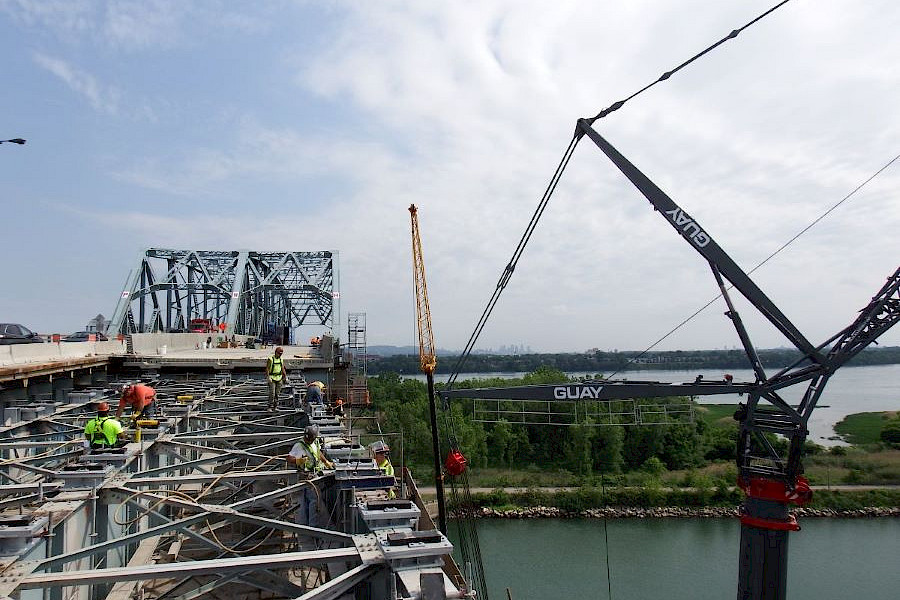
Photo: Installation of the banners on the Honoré Mercier Bridge
After eight years of highly complex work, the deck replacement program on the federal section of the Honoré Mercier Bridge — one of the largest projects ever carried out by First Nations in Canada— is completed. This major project won an award of excellence from the Société québécoise des professionnels en relations publiques.
Between 2008 and 2016, a total of 982 concrete panels were required to complete the entire bridge deck and extend the bridge’s service life to at least 75 years.
This significant achievement would not have been possible without the contribution of Mohawk workers and the collaboration of the Mohawk Council of Kahnawà:ke, the MRC de Roussillon, and our mobility partners. The project to replace the deck of the Honoré Mercier Bridge was a great example of cooperation between Nations and was based on respect, openness and understanding. The expertise developed over the years by JCCBI and Mohawk entrepreneurs led to the successful completion of very complex work on one of Greater Montreal’s most important bridges.

Photo. Deck replacement on the federal section of the Honoré Mercier Bridge (2016)
Exposed over the years to heavy traffic, weather conditions, and an abundant use of road salt, the structure of the Honoré-Mercier Bridge needed major repair work to increase its life span.
JCCBI adopted an active and preventive management approach and decided to fully replace the deck in the federal section of the Honoré Mercier Bridge, in 2008.
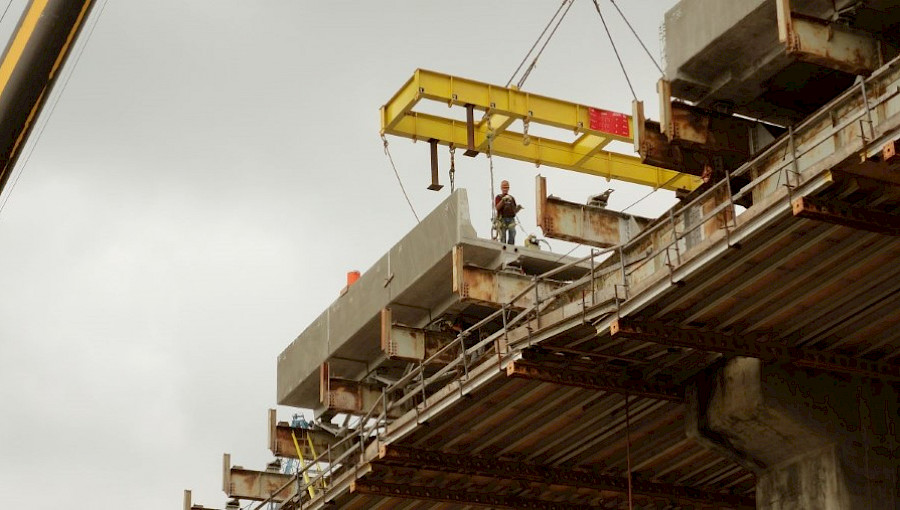
Photo. Deck replacement on the federal section of the Honoré Mercier Bridge (2012)
The Corporation becomes a wholly owned subsidiary of The Federal Bridge Corporation. lt also assumes responsibility for the federal section of the Honoré Mercier Bridge and its south approaches.
Under federal jurisdiction:
Under provincial jurisdiction:
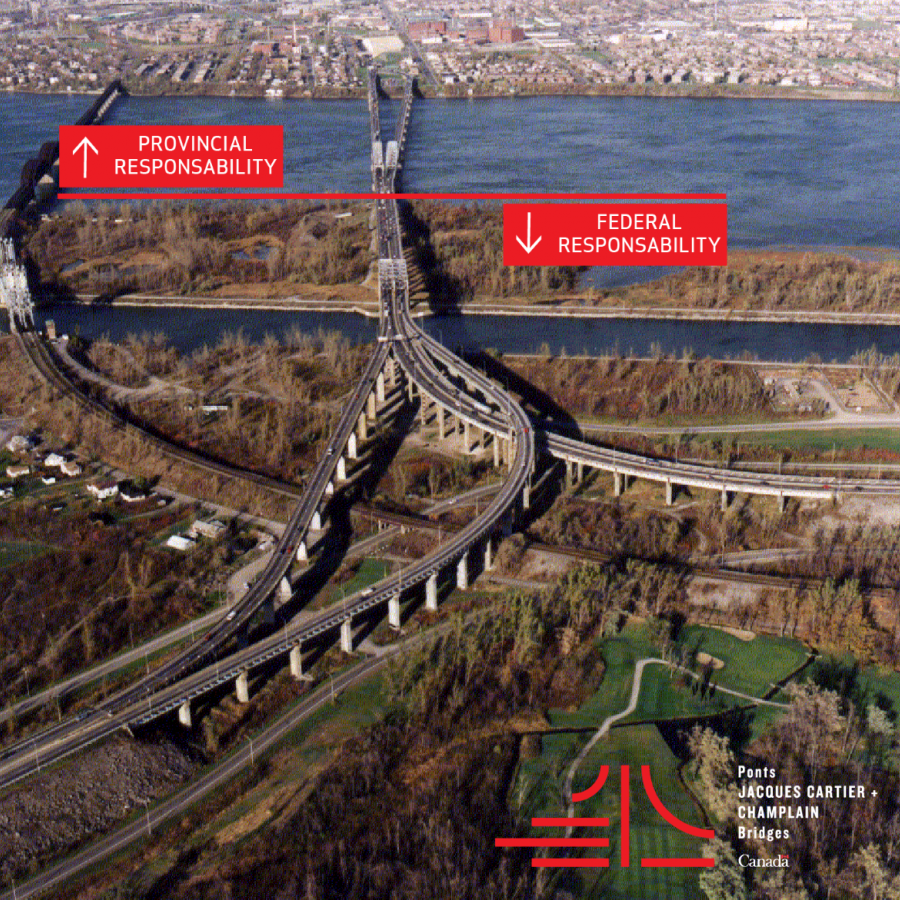
It was felt that the Mercier Bridge’s two lanes were inadequate for the constantly increasing traffic travelling across it, so the Ministère des Travaux publics du Québec had a second bridge built downstream from the first, currently managed by the provincial government.
In the federal section, the deck of the old bridge was modified so that it would have the same capacity as its “twin”. Minor changes were also made to the piers, as each pier was fully resurfaced with a new layer of reinforced concrete and were reshaped to match the piers of the new bridge.
In the provincial section, the bridge engineers had to devise an innovative method to erect the bridge piers, given the thick layer of glacier marl over the rock, the river’s depth, and the speed of the current. Since the St. Lawrence River is so deep at this point, the engineers decided not to use cofferdams and instead chose pneumatic caissons, a method that had not been used in Montreal in 25 years.
Together, the new and old bridge doubled the number of lanes between both shores from two to four (two lanes per direction). Traffic to the South Shore then started passing over the old bridge, and traffic to Montreal was routed over the new one.
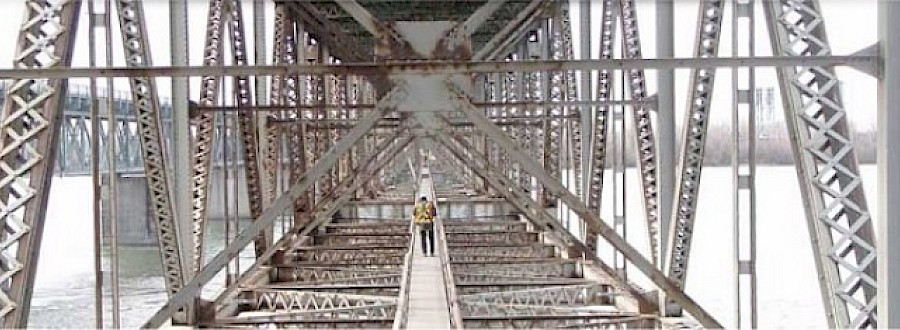
The toll system is abolished.
To cross the bridge, motorists in cars had to pay $.50, while trucks weighing 7,257 kg were charged $3.00.
For the St. Lawrence Seaway construction project, the St. Lawrence Seaway Management Corporation (SLSMC) started work to raise and extend the south section so that ships could pass underneath.
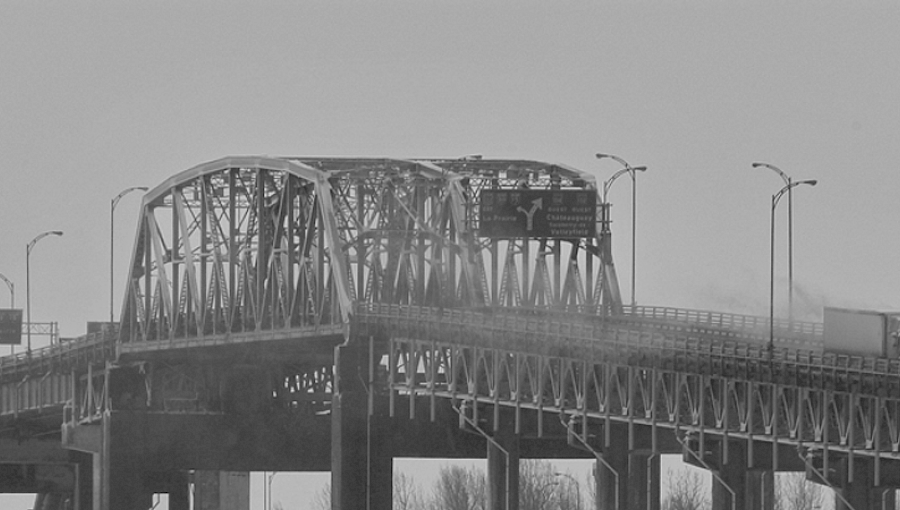
Its administration was transferred to the Government of Quebec in 1942.
Initially made up of two lanes that belonged to the Corporation du pont du lac Saint-Louis, the Honoré Mercier Bridge was inaugurated in 1934.
The bridge was opened to traffic on June 22, 1934, or 10 months before the scheduled completion date. It was originally 1361.25 m long. Its main steel arch span was 121.87 m long, and it had 11 steel spans and 31 reinforced concrete spans.
The board of the Corporation du pont du lac Saint-Louis chose this name at its 70th session on March 2, 1934 in homage to Honoré Mercier, Sr., and Honoré Mercier, Jr.
Honoré Mercier, Sr., (1840-1894) was a lawyer, a journalist, and the premier of Quebec from 1887 to 1891. He was responsible for the construction of many railroads and bridges to grow Quebec’s economy, increase settlement in the province, and develop the territory.
Honoré Mercier, Jr., (1875-1937), who was also a lawyer, was a member of the national assembly for Châteauguay from 1907 to 1936. He was Minister of Lands and Forests for the Gouin and Taschereau governments, which were in power from 1919 to 1936.
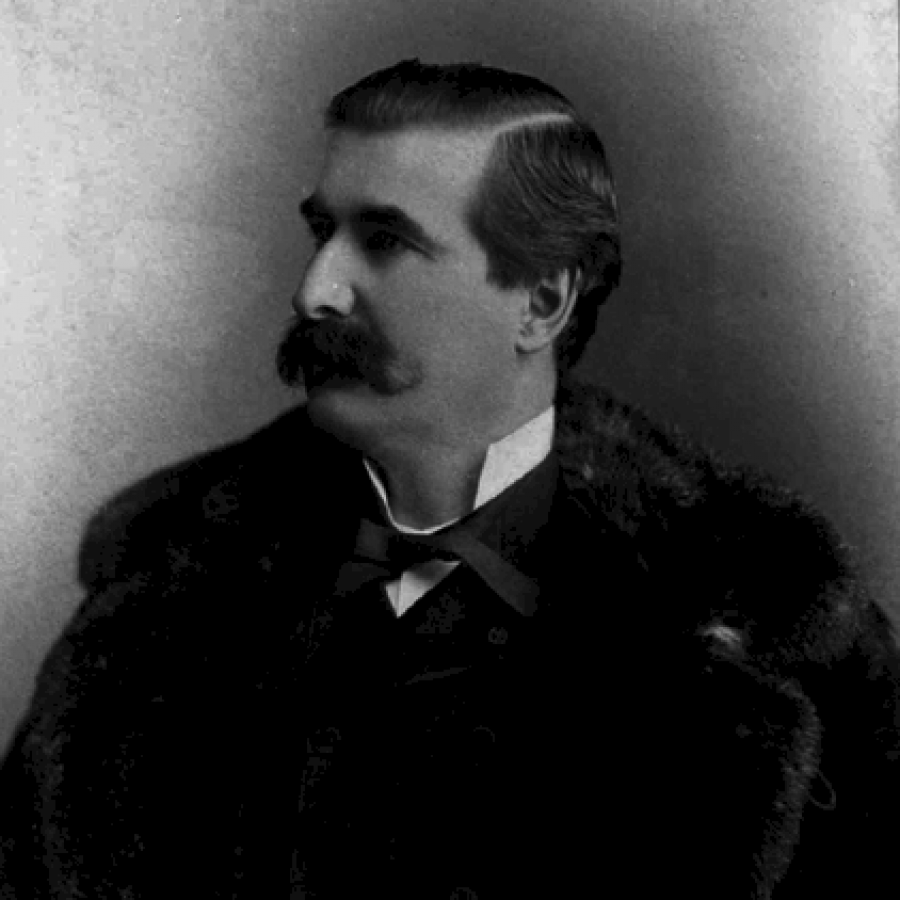
Photo. Honoré Mercier, Sr.
Construction of the bridge begins.
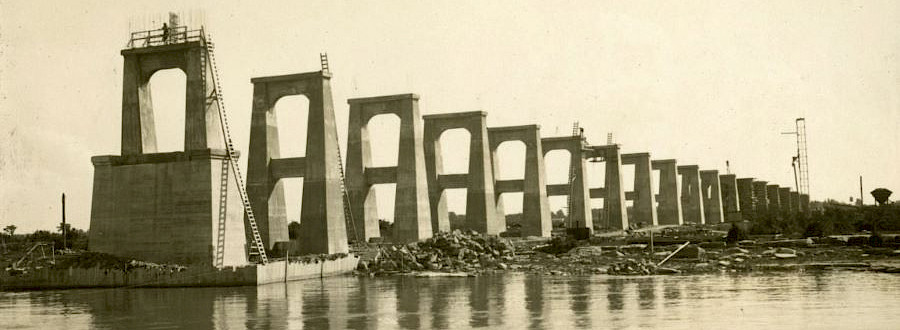
Photo credit: BAnQ
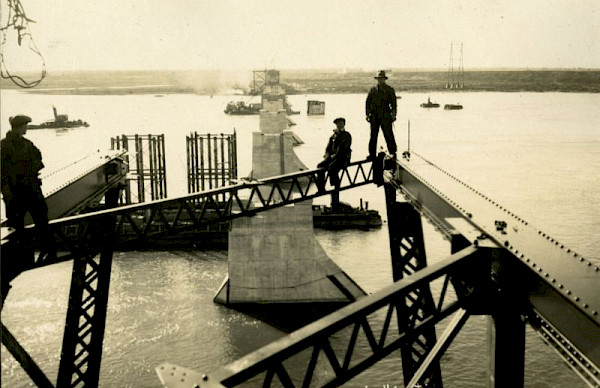
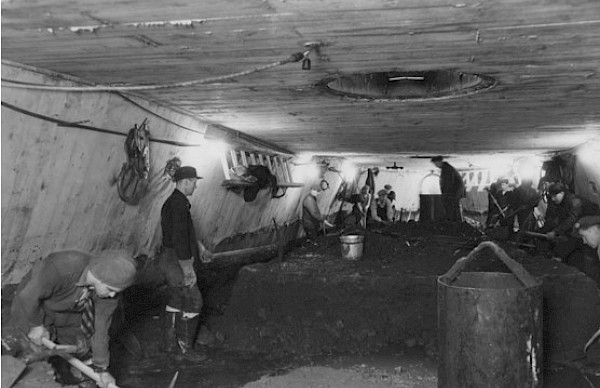
Photo credit (left): BAnQ
Photo credit (right): BAnQ
Its steel structure was built by the Dominion Bridge Company Limited as part of work funded by the government to address the economic downturn. The bridge was designed by 11 French Canadian engineers who were graduates of the École Polytechnique de Montréal.
Honoré Mercier was a journalist, lawyer and politician who is recognized as a visionary who worked for the interests of Quebec and French Canadians during the time of Confederation. In 1934, the Honoré Mercier Bridge, which was named in his honour, became the fourth structure after the Victoria Bridge, the Lachine Bridge and the Jacques Cartier Bridge to connect the Island of Montreal to the South Shore.
Did you know that Honoré Mercier started out in journalism?
Born to an extremely patriotic family, Mercier developed a love and pride for Quebec at a young age. Attracted by the law and journalism, Mercier first decided to try his hand in the newspaper business and began his career as the editor of Le Courrier de Saint-Hyacinthe. A few years later, he started studying the law. He very quickly opened his own firm and became known as the best criminal lawyer in Saint-Hyacinthe.
After the death of his first wife, he felt ready to dive into politics in 1871. Wanting to stay true to his convictions, he left the party after a debate about Francophone rights in New Brunswick, during which he called for unity among all Francophones in Canada . Barely two months later, the premier of Quebec, Henri -Gustave Joly de Lotbinière, asked Mercier to put his oratorial talents to good use and become the main spokesperson for the party. Elected to the National Assembly in June 1879, he soon became more popular than the premier. He himself became premier two years later and governed Quebec until 1891. He made his mark through his policy of provincial independence in response to the centralization of the federal government.
Throughout his time in office, Honoré Mercier helped Quebec evolve with projects like the railway from Québec City to Lac-Saint-Jean, the opening of an immigration office in Montreal, and the creation of a health board.
Today, a number of monuments stand in his honour, including a sculpture in front of the Québec City Parliament Building, on Honoré-Mercier Avenue.
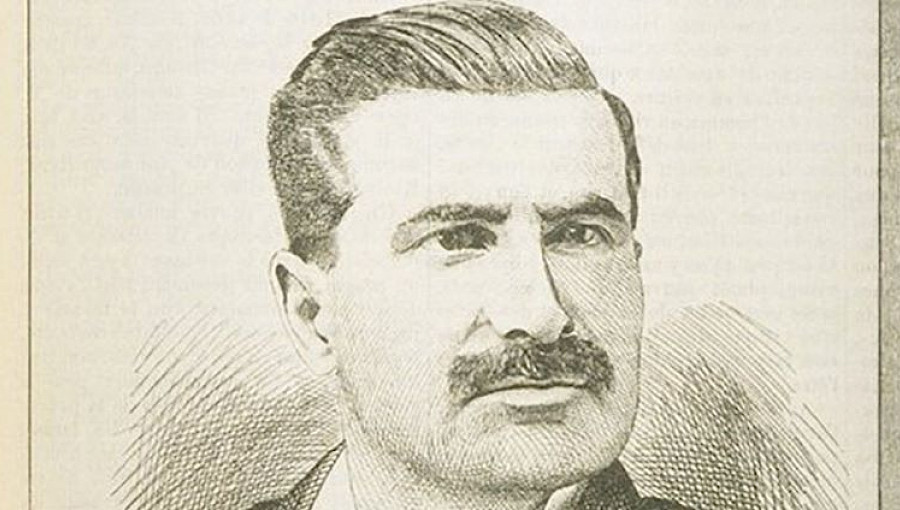
Photo credit: BAnQ
Born in Quebec City in 1867, Louis-Alexandre Taschereau was a lawyer and politician who served as premier of Quebec from 1920 to 1936. He was proud that the Honoré Mercier Bridge was the first bridge built under the direction of French-Canadian engineers, and he gave a speech filled with patriotism and praise for the builders at the official inauguration ceremony in 1934. What do we know about Louis-Alexandre Taschereau?
The son of a judge on the Supreme Court of Canada, Taschereau worked as a journalist before getting his law degree. Although initially destined for a brilliant legal career, he instead got involved in politics to the great surprise of his family. Given his family’s distinguished involvement in the province’s legal and political institutions, Taschereau quickly gained the trust of political authorities.
Louis-Alexandre Taschereau became a municipal councillor of his native city before becoming a liberal MNA and the Minister of Public Works and Labour. In 1920, he was elected Premier of Quebec. Worried about how the Great Depression was putting a financial strain on so many Quebeckers, he and his government enacted the first law on unemployment. Throughout his term of office, he showed his commitment to the Quebec people by working for provincial rights over natural resources, broadcasting, fishing, and international trade.
Louis-Alexandre Taschereau sat in the National Assembly for over 35 years, a record that was only beaten in the 1990s. He was named an Officer of France’s Legion of Honour in 1924 and a Commander in 1927, and he received its Grand Cross in 1934.
As the manager of the Honoré Mercier Bridge from 1934 to 1942, the Corporation du Pont du Lac Saint-Louis oversaw the construction of this fourth connection between Montreal and the South Shore.
Did you know that the Honoré Mercier Bridge was the first bridge in Quebec built without English Canadian or foreign engineers?
Eleven French-Canadian engineers, all of whom graduated from the École Polytechnique de Montréal, joined their efforts to work on this vast project. The Honoré Mercier Bridge was the first structure of its kind built only by French Canadians.
The work was not without its stumbling blocks. Economic instability limited provincial funding, and a thick layer of ice over the river forced the engineers to come up with innovative techniques to deal with the weather conditions. These creative engineers decided to build the bridge on pneumatic caissons, a method that hadn’t been used for many years.
Despite the technical challenges, the work finished 10 months ahead of schedule, and the two-lane bridge opened for traffic on June 22, 1934. The bridge’s management was transferred to the Government of Quebec in 1942.
Created to encourage visits from American tourists, the structure provided faster access to the state of New York, but motorists had to pay a toll to cross the bridge. At first, the toll was 50 cents, but it was then reduced to 25 cents before being abolished in 1962.
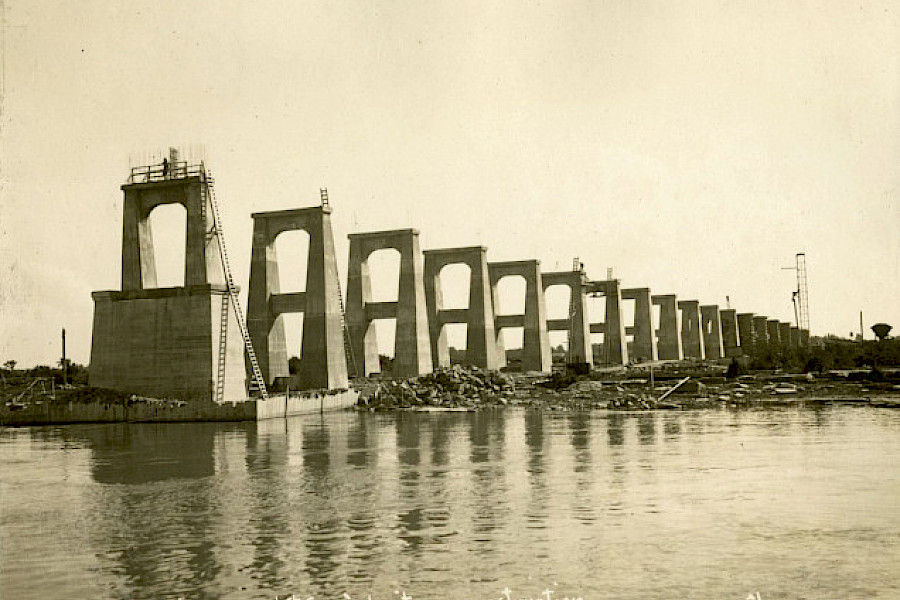
Photo credit: BAnQ


